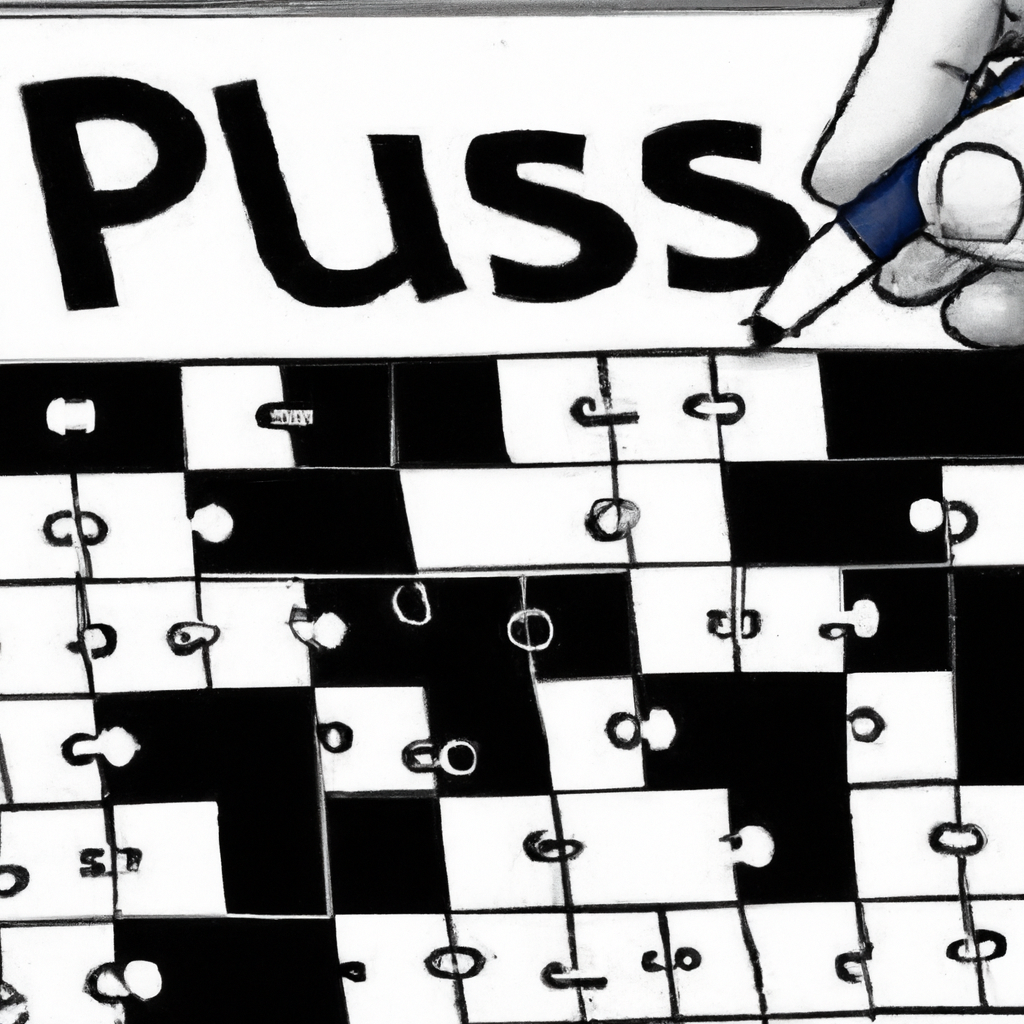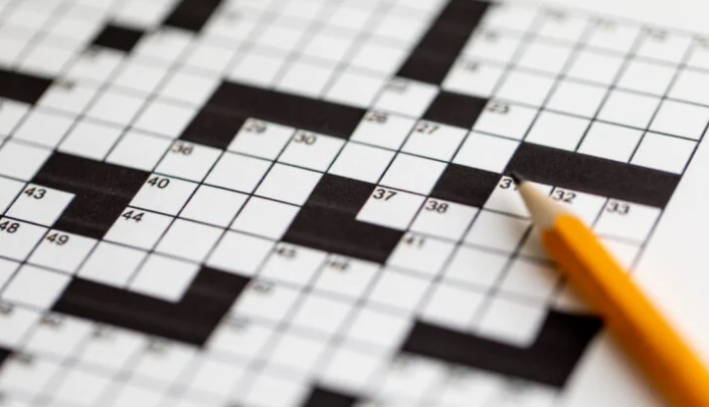So you’ve decided to tackle the New York Times crossword puzzle, but you’re stuck on a particular clue and feeling a bit puzzled yourself. Fear not, for this article will guide you through the art of solving NYT crossword clues with ease and much entertainment! Whether you’re a crossword enthusiast or just looking to sharpen your mental skills, we’ve got you covered. Get ready to unravel the mystery behind those tricky crossword clues and uncover the satisfaction of completing the puzzle, one clue at a time.

Understanding Crossword Clue Types
Crossword puzzles are a popular and entertaining pastime for many. They challenge our vocabulary, critical thinking, and problem-solving skills. To become proficient at solving crosswords, it is important to understand the different types of clue types that are commonly used. Each clue type requires a unique approach and understanding. Let’s delve into the various crossword clue types you may encounter.
Anagrams
Anagrams are clues that require you to rearrange a given set of letters to form a new word. The clue usually provides an indicator, such as “scrambled” or “mixed up,” that suggests an anagram is needed. For example, if the clue is “actress gone mad (5)”, the solution might be “drama,” where the letters of “actress” have been rearranged. To solve an anagram clue, try rearranging the letters while keeping the word length in mind.
Hidden Words
Hidden words clues involve locating a word hidden within a longer word or phrase. The clue often contains an indicator like “concealed” or “within” to suggest that a hidden word is present. For instance, if the clue is “friendly guy hiding in forest (4)”, the hidden word might be “nest,” concealed within “forest.” To find hidden words, carefully analyze the clue and the surrounding letters to identify any words hidden within the larger word or phrase.
Double Definitions
Double definition clues provide two separate definitions that both lead to the same solution. These clues can be tricky as they often involve words with multiple meanings. For example, if the clue is “a musical instrument or an inherited characteristic (4)”, the solution might be “gene,” which is both a musical instrument (guitar) and an inherited characteristic. To solve double definition clues, consider different meanings of the words and find a word that fits both definitions.
Homophones
Homophone clues involve words that sound alike but have different spellings and meanings. The clue usually contains an indicator like “sounds like” or “audibly” to suggest that a homophone is needed. For instance, if the clue is “large animal sounds like a color (3)”, the solution might be “ewe,” which sounds like the color “yew.” To solve homophone clues, listen for words that sound similar to the given clue and find a word with a different spelling but the same pronunciation.
Container/Contents
Container/Contents clues are based on the concept of one word “containing” or “enclosing” another word. The clue often contains indicators like “in” or “around” to suggest word containers. For example, if the clue is “wearing a hat inside a church (6)”, the solution might be “parish,” where the word “hat” is contained within “parish.” To solve container/contents clues, look for words that can be split into two parts, with one part “containing” the other.
Reversals
Reversal clues involve reversing the order of either a full word or specific letters to form the solution. The clue often contains indicators like “upset” or “backwards” to suggest a reversal is necessary. For instance, if the clue is “retired racecar driver (5)”, the solution might be “elcar.” To solve reversal clues, look for clue indicators and reverse the order of the word or letters as directed.
Charades
Charades clues require you to combine separate words to form the solution. Each word individually represents a different part of the solution. The clue often contains words like “with” or “and” to indicate the combination of words. For example, if the clue is “a kitchen utensil with a sharp edge (7)”, the solution might be “cleaver,” which is a combination of “clef” (a musical note) and “aver” (to affirm). To solve charades clues, break down the clue into segments and find words that fit each part.
Cryptic Definitions
Cryptic definitions are clues that provide a creative or alternate definition of the solution. These clues often involve wordplay and can be quite challenging. For example, if the clue is “the perfect number for a lobster dinner? (5)”, the solution might be “claws,” as lobsters have claws and the number five is the number of fingers on a hand. To solve cryptic definition clues, think outside the box and consider different interpretations and word associations.
Acronyms
Acronyms are clues that involve using the initial letters of other words to form the solution. The clue may provide an indicator like “initially” or “abbreviation” to suggest an acronym is needed. For instance, if the clue is “National Aeronautics and Space Administration (5)”, the solution might be “NASA.” To solve acronym clues, look for the initial letters of key words that form a common acronym.
Abbreviations
Abbreviation clues involve using shortened forms of words to find the solution. The clue may provide indicators like “short” or “briefly” to suggest an abbreviation is required. For example, if the clue is “doctor’s degree (3)”, the solution might be “PhD,” which is an abbreviation for “Doctor of Philosophy.” To solve abbreviation clues, look for shortened forms of words that fit the given clue.
Effective Crossword Solving Strategies
Now that we have covered the various crossword clue types, let’s explore some effective strategies for solving crosswords more efficiently.
Start with Easy Clues
Begin by tackling the easier clues first. These are typically short words or phrases that are less ambiguous and can provide a solid foundation for completing the puzzle.
Fill in the Blanks
If you come across a clue with blank spaces, focus on filling in the letters that you are confident about. This will help reveal other letters and give you a better chance of solving adjacent clues.
Use Crossword Dictionaries
Crossword dictionaries can be invaluable resources when you encounter unfamiliar words or need more information about a particular clue. They provide definitions, synonyms, and other helpful information to aid in your solving process.
Work from the Bottom Up
Starting from the bottom of the puzzle and working your way up can be an effective approach. This allows you to build a solid foundation and fill in the longer answers more easily.
Use Crossword Apps or Websites
Crossword-solving apps and websites are great tools that offer hints, check answers, and provide additional resources to help in your solving journey. They can be particularly handy when you’re stuck on a certain clue or need some guidance.
Focus on Common Crossword Clue Words
Crosswords often include words that frequently appear as clues in puzzles. Familiarize yourself with these common words, such as “river,” “mountain,” or “capital,” to have a head start in solving related clues.
Learn Crossword Clue Patterns
As you solve more crosswords, you will start noticing recurring clue patterns. Observing and understanding these patterns can greatly enhance your solving speed and accuracy.
Be Open to Multiple Meanings
Many crossword clues have words with multiple meanings. Stay open-minded and consider all possible interpretations to find the correct solution.
Consider Wordplay and Puns
Crosswords often incorporate wordplay, puns, and other clever constructions. Don’t be afraid to think creatively and look beyond the literal meaning of a clue to unravel its intended wordplay.
Practice and Persistence
Like any skill, crossword-solving requires practice. The more puzzles you solve, the better you will become. Stay persistent, challenge yourself, and don’t be discouraged by occasional roadblocks.
Decoding Anagrams
Anagrams are a common crossword clue type that requires you to rearrange a given set of letters to form a new word. Let’s dive deeper into some strategies for decoding anagrams.
Rearranging Letters
To solve an anagram clue, start by rearranging the letters provided in the clue. Experiment with different combinations until you find a word that fits the word length and the context of the clue.
Looking for Clue Indicators
Anagram clues often contain indicators that suggest a rearrangement is necessary. Words like “scrambled,” “mixed up,” or “reversed” can signal the presence of an anagram. Pay close attention to these indicators to identify anagram clues more easily.
Checking Syllables and Word Lengths
While rearranging letters, keep the word length and syllable count in mind. If the clue specifies a certain word length or syllable count, make sure the rearranged word matches those criteria.
Considering Contextual Hints
Anagrams often relate to the context of the clue or the theme of the puzzle. If the clue provides additional context, such as a related word or a specific theme, use that information to guide your anagram-solving process.
Using Trial and Error
If you’re unsure about a particular anagram solution, try testing it by inserting the rearranged word into the crossword grid. If it doesn’t fit or doesn’t make sense in relation to the intersecting letters, keep experimenting until you find the correct anagram solution.
Discovering Hidden Words
Hidden words clues require you to identify a word hidden within a longer word or phrase. Let’s explore some strategies for discovering hidden words.
Identifying Clue Indicators
Hidden word clues often contain indication words like “concealed,” “within,” or “buried.” These clues serve as hints to locate the hidden word within the larger word or phrase. Pay attention to such indicators to identify hidden words more effectively.
Finding Hidden Words within Longer Words
Thoroughly analyze the letters of the longer word or phrase in the clue. Look for consecutive letters that form a recognizable or meaningful word. Rearranging the letters may help reveal the presence of a hidden word.
Considering Synonyms and Context
Sometimes, the hidden word may not be an exact match for the solution. It could be a synonym or related word that fits within the context of the clue. Consider synonyms or related words that could be hidden within the given letters.
Using Word Lists and Crossword Software
When stuck on a hidden word clue, consult word lists or crossword-solving software. These resources can provide a list of potential hidden words based on the available letters. Use these tools for additional inspiration and to broaden your options.

Deciphering Double Definitions
Double definition clues provide two separate definitions that lead to the same solution. Here are some tips for deciphering double definitions.
Identifying Word Pairs
Look for two separate definitions in the clue. Each definition should independently lead to the same solution. Analyze the definitions and try to find a word that fits both.
Considering Different Meanings
Double definition clues often involve words with multiple meanings. Explore different meanings for each definition and find a word that encompasses them both.
Eliminating Misdirections
Double definition clues can sometimes include misdirections or wordplays to mislead solvers. Stay focused on identifying two distinct yet related definitions to solve these clues accurately.
Using Contextual Clues
If the double definition clue is part of a larger crossword puzzle, consider how the intersecting letters or other clues can provide contextual hints. These hints can narrow down the range of potential solutions and make it easier to find the correct answer.
Solving Homophones
Homophone clues rely on words that sound alike but have different spellings and meanings. Here’s how you can crack homophone clues.
Recognizing Homophone Indicators
Homophone clues often include indicators like “sounds like,” “audibly,” or “in conversation” to signal the use of homophones. Pay attention to such indicators to recognize that a homophone is needed.
Listening for Sound Alike Words
When solving homophone clues, focus on words that sound similar to the given clue. Think of alternative spellings or variations that match the same pronunciation. This requires careful listening for the intended sounds.
Considering Alternative Spelling
Homophones can have alternative spellings that sound identical. For example, “you” and “ewe” have different spellings but sound exactly the same. Keep in mind these alternative spellings as you solve homophone clues.
Understanding Phonetic Similarities
Pay attention to the phonetic structure of words when solving homophone clues. Words with similar phonetic characteristics are more likely to be homophones. Explore combinations of letters that produce similar sounds.
Using Word Associations
Word associations can assist in solving homophone clues. Look for words that are often associated with the given clue, as they might have homophones. Brainstorm various words related to the context until you find the homophone solution that fits.
Cracking Container/Contents Clues
Container/Contents clues involve one word “containing” or “enclosing” another word. Let’s break down the strategies for solving container/contents clues.
Identifying Clue Indicators
Container/Contents clues often contain indicators like “in” or “around” to suggest the presence of a container or contents relationship. These indicators guide you to find the two words involved in the clue.
Determining Container and Contents Words
Examine the clue to determine which word is the container and which is the contents. The container word surrounds or encloses the contents word. Find the relationship between the two words and how they fit together.
Understanding Word Relationships
Understand the relationship between the container and contents words. They might have a logical connection based on their meanings, such as “box” containing “tin.” Consider synonyms or words that share related concepts as potential solutions.
Considering Word Order and Syntax
Pay attention to the word order and syntax of container/contents clues. The clue’s sentence structure can provide valuable hints for determining which word plays the role of the container and which word acts as the contents.
Unraveling Reversals
Reversal clues involve flipping either a full word or specific letters to form the solution. Here’s how you can unravel reversal clues.
Identifying Reversal Indicators
Reversal clues include indicators like “upset,” “backwards,” or “turned around” to signal the need to reverse the order of letters or words. Look for these indicators to recognize a reversal clue.
Flipping Words or Letters
When solving a reversal clue, determine whether the entire word needs to be reversed or just a portion of it. Follow the clue’s instructions on what exactly needs to be flipped and proceed accordingly.
Considering Positional Hints
Pay attention to the positioning of words or letters within the clue. Sometimes, a reversal might involve only the first or last letters, or a specific group of letters. Use the positional hints to accurately reverse the required elements.
Looking for Clue Synonyms or Antonyms
Clue synonyms or antonyms can help identify reversal clues. If a word in the clue has an opposite meaning or a synonym that indicates a reversal, it suggests that flipping is necessary to find the solution.
Solving Charades
Charades clues require you to break the clue into segments and combine separate words to form the solution. Here are some tips for solving charades
Breaking Clue into Segments
Divide the clue into separate segments or words that can be combined to reach the solution. Identify how each segment relates to the final answer or what role it plays in constructing the solution.
Looking for Example Words
Once you have segments of the clue, search for example words that match each segment. These example words should fit together to form the final solution. Consider synonyms or words with similar meanings that align with the clue segments.
Considering Word Length and Context
The word length of each segment can provide valuable information. If the solution is a six-letter word, make sure each segment aligns with this length. Additionally, consider the context of the clue to determine how each segment fits into the overall solution.
Determining Word Order
When combining the segments, pay attention to the order in which they should be arranged. The clue may provide hints on the sequence or the logical flow of the segments. Follow these hints to find the correct word order.
Understanding Clue Indicators
Clue indicators in charades clues provide hints on how each segment should be treated. Look for words like “with,” “and,” or other similar indicators that guide you in combining the individual segments correctly.
Cracking Acronyms and Abbreviations
Acronyms and abbreviations appear frequently in crossword puzzles. Here are some strategies to crack these clue types.
Recognizing Clue Indicators
Look for indicators such as “initially,” “abbreviation,” or “short” that suggest the presence of an acronym or abbreviation. These indicators provide clues to identify the solution type.
Expanding Acronyms
When confronted with an acronym clue, expand the initial letters to form the full-length words. Use your knowledge or refer to a crossword dictionary to determine what the acronym stands for.
Considering Abbreviation Standards
Different fields or disciplines have their own sets of standard abbreviations. Familiarize yourself with common abbreviations across various domains to decipher abbreviation clues more efficiently.
Using Word Lists and Contextual Clues
If you’re unsure about an abbreviation, consult word lists or crossword-solving software that provide lists of common abbreviations. Additionally, look for contextual clues within the puzzle or the intersecting words to narrow down the possibilities.
Researching Common Acronyms
Sometimes, solving an acronym clue requires general knowledge about well-known acronyms. If you encounter unfamiliar acronyms, use online resources or reference materials to research and expand your knowledge base.
Crossword solving is an enjoyable and rewarding activity that requires a combination of analytical thinking, vocabulary, and problem-solving skills. By understanding the different clue types and employing effective strategies, you can improve your crossword-solving abilities and confidently tackle even the most challenging puzzles. With practice and persistence, you’ll become a seasoned crossword solver, ready to conquer any crossword that comes your way. So grab a pencil and let the crossword adventure begin!





